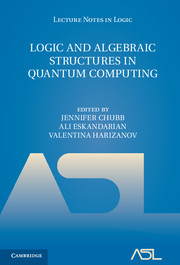Book contents
- Frontmatter
- Contents
- Preface
- Introduction
- 1 A (very) brief tour of quantum mechanics, computation, and category theory
- 2 Could logic be empirical? The Putnam-Kripke debate
- 3 The essence of quantum theory for computers
- 4 Fiber products of measures and quantum foundations
- 5 Operational theories and categorical quantum mechanics
- 6 Relating operator spaces via adjunctions
- 7 Topos-based logic for quantum systems and bi-Heyting algebras
- 8 The logic of quantum mechanics – Take II
- 9 Reasoning about meaning in natural language with compact closed categories and Frobenius algebras
- 10 Knot logic and topological quantum computing with Majorana fermions
- Index
3 - The essence of quantum theory for computers
Published online by Cambridge University Press: 05 June 2016
- Frontmatter
- Contents
- Preface
- Introduction
- 1 A (very) brief tour of quantum mechanics, computation, and category theory
- 2 Could logic be empirical? The Putnam-Kripke debate
- 3 The essence of quantum theory for computers
- 4 Fiber products of measures and quantum foundations
- 5 Operational theories and categorical quantum mechanics
- 6 Relating operator spaces via adjunctions
- 7 Topos-based logic for quantum systems and bi-Heyting algebras
- 8 The logic of quantum mechanics – Take II
- 9 Reasoning about meaning in natural language with compact closed categories and Frobenius algebras
- 10 Knot logic and topological quantum computing with Majorana fermions
- Index
Summary
Abstract. Quantum computers take advantage of interfering quantum alternatives in order to handle problems that might be too time consuming with algorithms based on classical logic. Developing quantum computers requires new ways of thinking beyond those in the familiar classical world. To help in this thinking, we give a description of the foundational ideas that hold in all of our successful physical models, including quantum theory. Our emphasis will be on the proper interpretation of our theories, and not just their statements. Our tact will be to build on the concept of information, which lies central to the operation of not just computers, but the Universe. For application to quantum computing, the essence of quantum theory is given, together with special precautions and limitations.
Introduction. Having a grasp on the ideas behind a theory helps to apply it correctly, to understand its limitations, and to generate new ideas. Getting a firm hold on quantum theory is not an easy task, because our experiences and even our genetic predispositions have been developed in a world in which quantum effects are largely washed out. Remarkably, our predilection for finding logic behind the behavior of what we observe, including that of electrons and atoms, has led us to quantum theory, a description of nature that is hard for us to conceptualize, but is logical, accurate, and explains a wide variety of phenomena with only a few statements and input.
As background to quantum theory and quantum computing, an attempt is made here to give the primitive notions and essential observations that underlie current physical theories, so that foundational ideas are explicit, and a common language is established. In our description, information storage and transfer is made central. A short description of quantum theory follows, and then applied to quantum computing, focusing on what the theory says, and particularly does not say, in areas where conceptual difficulties have arisen.
Physical theory and reality. A physical theory is a logical model capable of making predictions of what we observe. It is judged by its accuracy in matching measurements, and by its economy, i.e. whether the proposed theory has only a few relationships and input data needed for its ability to explain observations over a wide realm.
- Type
- Chapter
- Information
- Logic and Algebraic Structures in Quantum Computing , pp. 42 - 70Publisher: Cambridge University PressPrint publication year: 2016



